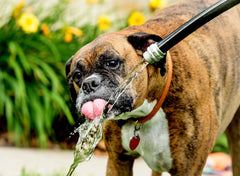
Indoor Spring Cleaning Safety for Pet Owners
Spring is almost here, and in true warm weather tradition, it’s time to deep clean the house.
Spring cleaning typically involves pulling everything from under the beds, wiping baseboards, and even getting behind the appliances. Most people also pull the screens from their windows to hose down, call in the pest service to keep the newly hatching bugs from entering their home, and deep clean their carpets. Some homes undergo renovations throughout this time of year, too. While it may make the house feel new again, all of these cleaning and updating choices pose serious risks for pets.

Indoor Spring Cleaning Safety for Pet Owners
Never leave windows open without their screens properly installed. Sneaky cats or clumsy dogs can accidentally end up falling.
Almost all cleaning products, even all natural ones, contain chemicals that may be harmful to pets. The key to using them safely is to read and follow label directions for proper use and storage.
The MSPCA provides the following helpful list of common cleaning products and their possible affects on your pets:
Acids (toilet bowl cleaners, pool sanitizers)
These products have a low pH which can cause localized tissue damage on contact. Ingestion can result in vomiting (sometimes with blood), ulcers in the mouth and esophagus, and intense pain. The pain may help limit the amount of exposure. A splash in the eye can damage the cornea.
Alkalis (drain openers, dishwasher detergents, toilet bowl cleaners, swimming pool products)
Alkalis are products with a high pH. They can cause severe tissue damage, vomiting with blood, fever, and excessive salivation. These products don’t cause much pain on initial contact, so exposures may be more prolonged. It may take several hours before signs of pain and inflammation are evident, and the full extent of the damage done may not be apparent for 12 hours.
Bleaches (chlorine and color-safe)
Depending on the route of exposure, bleach can cause prolonged vomiting, burns to skin, coughing, and trouble breathing.
Detergents (dishwashing soap, various household cleaners)
Detergents can be very irritating to the gastrointestinal tract and eyes. Signs of ingestion are usually mild vomiting and diarrhea, although ingestion of large quantities can result in more severe stomach upset.
Cationic Detergents (fabric softeners, sanitizers)
Ingestion of these types of detergents can also cause vomiting and diarrhea. In addition, exposure to cationic detergents can be toxic to the nervous system. Depression, seizures, muscle weakness, and coma have been reported following exposure.
While exposure to any cleaner can potentially cause mild irritation, there are some products on the market that are relatively pet-safe. Nature’s Miracle Stain and Odor Remover, OdoBan Neutral pH floor cleaner, Seventh Generation laundry detergent, Simple Green All Purpose Cleaner, and many other products are specifically marketed to be safe for people, pets, and the environment.
Elmhurst Animal Care Center recommends using the following:
Baking soda is an inexpensive, non-toxic product that you probably already have in your cupboard, but did you know it works wonders as a cleaning agent?
- Sprinkle a layer of baking soda in the litter box before adding fresh litter to neutralize odor
- Mix with water and use to scrub sinks, pet food and water bowls, and other non-porous surfaces
- For embarrassing toilet bowl rings, pour baking soda and lemon juice into the bowl, let sit for 10 minutes, and scrub
- Add ½ cup to the laundry to deodorize pet bedding
Distilled white vinegar has been a beloved all-purpose cleaner for decades. Although it has a distinctive odor, it generally evaporates within a few minutes, leaving your home sparkling clean. Simply combine ½ cup of white vinegar with 1 gallon of water and pour into a spray bottle for a safe, effective, all-purpose cleaner for:
- Glass
- Sinks and faucets
- Litter boxes
- Feeding dishes
- Non-porous pet toys
- Carpet stains (mix with salt, borax, or cornstarch)
If you are repainting, remodeling, or updating your home, remember that products such as paints, mineral spirits and solvents can be toxic to your pets and cause severe irritation or chemical burns. Carefully read all labels to see if the product is safe to use around your furry friends. Also, be cautious of physical hazards, including nails, staples, insulation, blades and power tools. It may be wise to confine your dog or cat to a designated pet-friendly room during home improvement projects.
Something to note: The Environmental Protection Agency (EPA) now offers a "Safer Choice" logo, which can be found on more than 2,000 products offering safer packaging and ingredients, but that doesn't mean these products don't pose risks for determined cats and dogs. Ensure that you are disposing of containers properly and keeping everything out of the reach of your furbabies.




Leave a comment